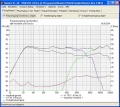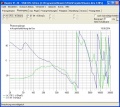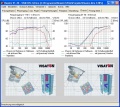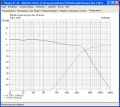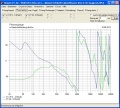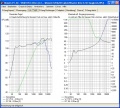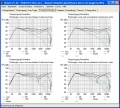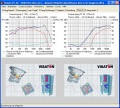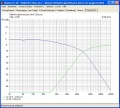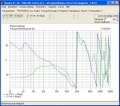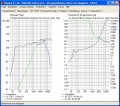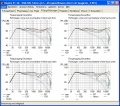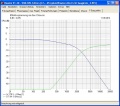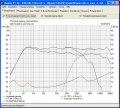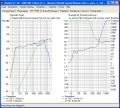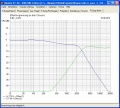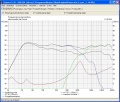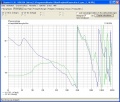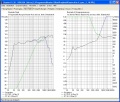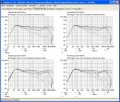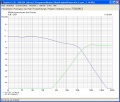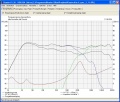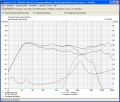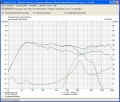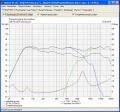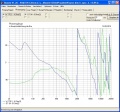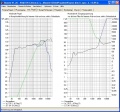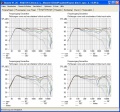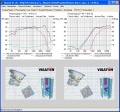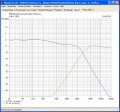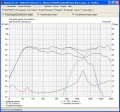Visaton Alto II
Data
Visaton loudspeaker Alto II (kit)
Short description
- The elegant Alto II bass reflex floorstanding speaker delights with its fantastic bass reproduction,
- which puts the performance of many a speaker twice its size in the shade. (Hifi Test)
Data
General:
- Manufacturer: Visaton
- Model: Alto II
- Years of manufacture: ?-current
- Made in: Germany
- Color: Self-made, selectable.
- Weight: X kg
- New price approx.: 226.15 Euro/pair kit without wood (2014)
Technical data:
- Type: 2-way bass reflex
- Rated power: 60 watts
- Music power: 100 watts
- Net volume: 28 liters
- Sound pressure level: 83 dB (1W/ 1m)
- Crossover frequency: 3,500 Hz
- Impedance: 4 Ohm
- Frequency response (-10 dB): 40- 22,000 Hz
- tweeter: DT94-8 (8 Ohm)
- bass-midrange driver: WS170S-4 (4 Ohm, rubber surround, long excursion)
- Crossover: Alto I (except shelf cabinet identical in construction)
- bass reflex tube: BR 15.34 (full length)
- Damping material: polyester wool 250 grams
- cabinet material: 19 mm chipboard or MDF
- Outer dimension height: 800 mm
- Outer dimensions width: 230 mm
- Outer dimension depth: 230 mm
Crossover conversion/improvement
- I show it only as pictures, first the old values, then the new ones. In forums I read about Alto I with DTW72?, of course this crossover is not for that.
- Conversions can be used 1:1 also for the Visaton Alto I. (Only if DT94-8 is installed!)
- The sections are numbered as FWM (crossover modifications).
- From FWM1.3 on it gets a bit more professional
- From FWM2 on it's actually a new crossover design. Get a new circuit board.
- Personally, I would build the FWM2.1 with FWM2.2 improvement. I'm a sucker for warm boxes.
- FWM0 Original
- FWM1 to FWM1.2 Fitting trials with suction circuits
- FWM1.3 Straight Box (Fast Studio)
- FWM2 Warm Box
- FWM2.1 Warm-hearted box with elevations
- FWM2.2 Warm-hearted box with enhanced bass
- FWM3 Natural Box
FWM0: Original, before modification
- Bad phase in the transition area
- Human sensitive range 2kHz - 4kHz is too exaggerated.
- Tends to distort from 1000Hz to 7kHz.
FWM1: With suction circuit as mentioned in forums at WS170-4 ohms
- I have to say, unscrew the speaker, and right to the terminals the three parts and good to go.
- For me it would still be a bit too brilliant in the high frequency (from 8 KHz). But the simplicity speaks for this solution.
Marked red parts in the crossover need to be purchased. Approx. 8,- Euro / speaker. The shrillness is reduced (-3db 2kHz-4kHz). Phase unfortunately unchanged middle class.
FWM1.1: with suction circuit, improved version on WS170-4 Ohm
- For all of you who have already done the suction circuit, only one capacitor would need to be replaced.
- For me it would still be a bit too brilliant in the high frequencies (from 8 KHz). But the simplicity speaks for this solution.
- Marked red parts in the crossover need to be bought. Approx. 8,- Euro / speaker.
Better phase, less distortion in the crossover area. 7kHz range flattened
FWM1.2: with absorption circuit as mentioned in forums at DT94-8 Ohm
- high frequency range is smoothed out
- Phase unfortunately unchanged midrange.
FWM1.3: And just flattened clean?
- I'm steamrollering over the frequency response, may be someone likes that.
- At crossover frequency I'm in phase, ok a little more steam at the tweeter in the power (a little more excursion).
which doesn't mean that it has to be louder there -> phase adder.
- Marked red parts in the crossover need to be bought.
- Straight frequency response (almost studio speaker)
- Very good phase, less distortion in the crossover area
Omnidirectional sound distribution improved from 3 kHz to 8 kHz
- Rather for musicians, too present for the normal listener.
Conversion costs: approx. 7,- Euro per speaker. Some rebuilding time, an experienced driver in one hour.
Note:
- I would mechanically split the trace between 3.3 uF and 0.33 mH.
- And solder the coil 0,22 mH and resistor 10 Ohm parallel to it.
If necessary, glue the parts to the switch with construction glue. That's all. But don't glue the coils together, they have to be as far apart as possible.
FWM2: Now it will be like an old fat Boston
- Here I'm recreating the suction circuit, but at crossover frequency I'm in phase, ok a little more steam on the tweeter in power (a little more excursion),
which doesn't mean it has to be louder there -> phase adder.
- Marked red parts in the crossover need to be bought.
- Smooth frequency response (English, warm box)
- Very good phase, less distortion in the crossover area
Omnidirectional sound distribution improved from 3 kHz to 8 kHz Good all-round speaker that won't be given away again. Modification costs: approx. 22,- Euro per speaker. Some rebuild time, one experienced driver in one hour
FWM2.1: Now it will be like an old fat Boston, with gimik treble boosts
- Almost the same as above, except for two switchable resistors.
- The phase values and omnidirectional characteristics are no longer significantly affected, that's why you can make it switchable.
- If the switches are open, the values from the previous section apply again.
- I would mount the switches at the back outside of the cabinet, and label them.
- Marked red parts in the crossover need to be bought.
- Smooth frequency response (English Warm Box)
- Very good phase, less distortion in the transition area
Omnidirectional sound distribution improved from 3 kHz to 8 kHz Treble boost switchable +0.8db 5kHz - 20kHz (total boost) treble boost switchable +0.8db 6kHz - 20kHz (rising edge, adds brilliance on demand)
- Good allround speaker that won't be given away.
- Can be adjusted to extreme brilliance.
Modification costs: approx. 28,- Euro per speaker. Some rebuilding time, an experienced in two hours
FWM2.2: Bass enhancement
Note bass improvement: Replacing the 1.5mH/0.6 ohm coil with a 1.5mH/0.17 ohm would result in a rounder bass by about +0.6db in the 70Hz - 500 Hz range. A bit of a material battle there. (Ferrobar roller core 58: HQ58/1.5/160 Audyn roller core coil 1.50 mH R=0.07 Order No. 1340257 16 Euro/each at intertechnik.ch, with such a small resistance of 0.07 Ohm the change is only minimally improved in frequency response (+0.05db) compared to the 0.17 Ohm coil. Just don't exceed 0.17Ohm anymore).
- In this version modification costs: approx. 28,- Euro component costs per speaker.
FWM3: the true to nature
- This speaker is voice strong and more neutral, with treble boost also brilliant.
- It is fresh, but not too obtrusive. It can no longer be described as warm.
- I would put the S1 switch on the back outside of the cabinet, and label it.
- An improved bass coil 1mH/0.17Ohm is used. Or smaller Ohm value are ok.
- Adjusted frequency response (fresh, natural)
- very good phase, less distortion in the transition area
- omnidirectional response improved from 3 kHz to 8 kHz
- With option treble boost switchable +0.8db 6kHz - 20kHz (rising edge, adds brilliance on demand)
- Good allround speaker that won't be given away.
- Brilliance can be adjusted.
Conversion costs: approx. 28,- Euro per speaker. Some rebuilding time, an experienced person in two hours.
The Boxsim project data on the FWM's
[http://filebin.ca/1zWN7eNrIGFf/VisatonAltoIundII.zip ]
Grateful for feedback
- Yes I don't have those parts in my house, and I never had the Alto either, but with those exact drivers I had once built a BB4-Basrefelx tuning for a bass player.
- So he could hear himself. It was bad quality in the bass. I know those parts well.
- The WS170S-4 is very good-natured I find.

